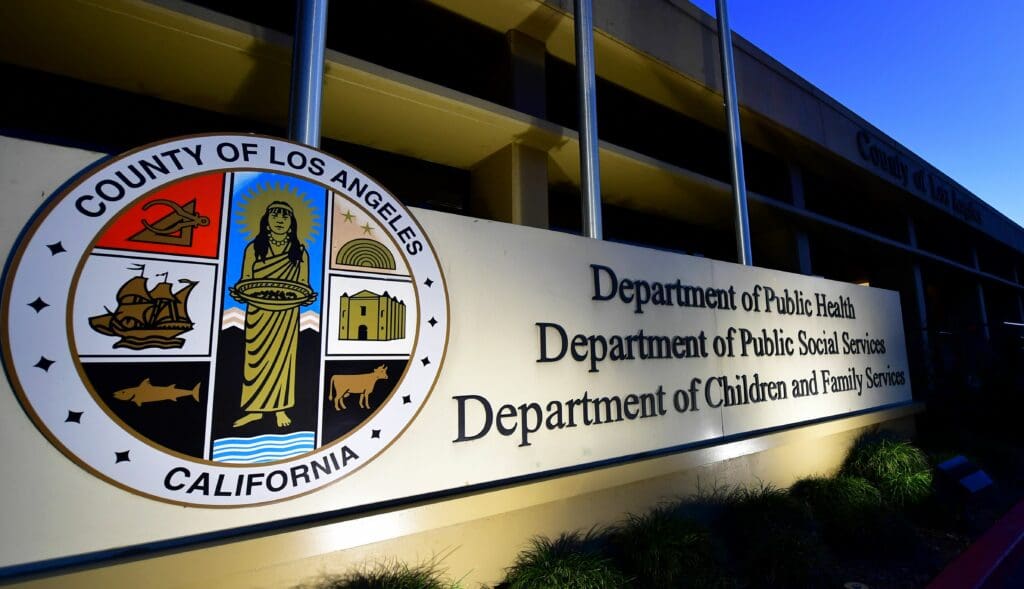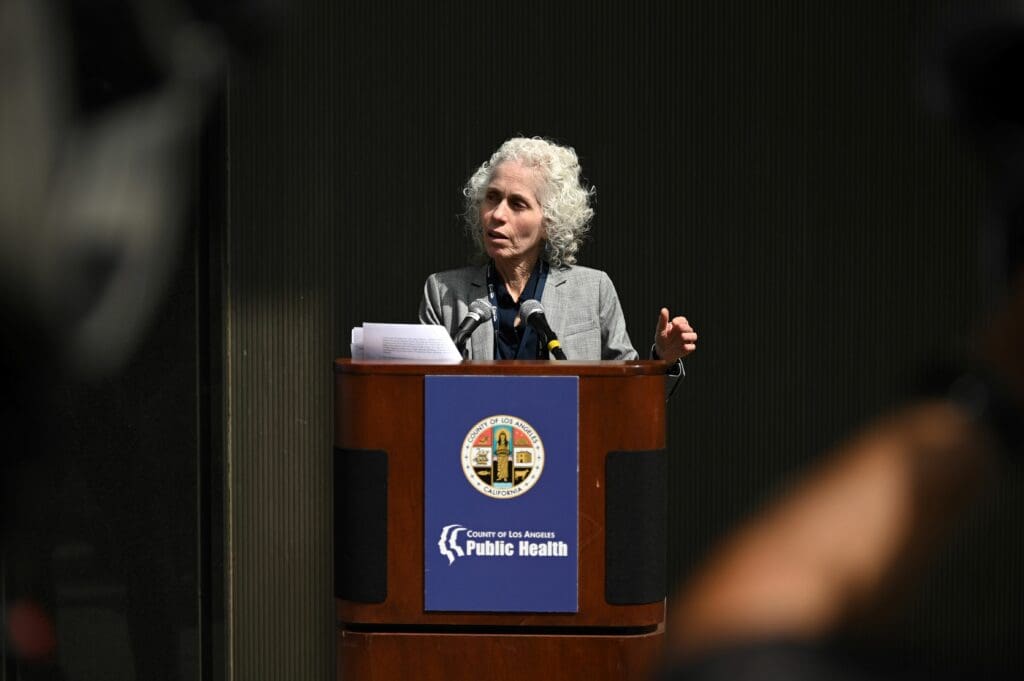Coronavirus
Did Barbara Ferrer Fail to Protect L.A.’s Most Vulnerable from COVID?
Defenders of L.A.’s public health chief see a fierce advocate for equity but many question her record and leadership style.
Co-published by L.A. Taco

Amid the resurgence of COVID-19, the dog days of summer have not been kind to the nation’s public health leaders. When California’s public health director and New York City’s health commissioner stepped down under pressure this month, they joined a list of nearly 50 state and local public health officials who have quit, been fired or retired since April.
Co-published by L.A. Taco
One of the highest-profile exceptions to the COVID-era purges is Barbara Ferrer, the director of the Los Angeles County Department of Public Health (LAC DPH). Ferrer has received death threats while largely eluding public criticism from the media or political and civic leaders. But as Angelenos come to grips with the far-reaching policy failures that turned L.A. County into a COVID-19 hotspot, Ferrer — along with the Board of Supervisors, L.A. Mayor Eric Garcetti, other elected officials and county Health Services chief Christina Ghaly — may face heightened scrutiny for a range of troubling facts:
- L.A. County accounts for nearly half of the state’s COVID-19 deaths, with more than 5,500 fatalities, though it is home to only 25 percent of California’s population.
- More than 233,000 county residents have tested positive for COVID-19, reflecting poorly on decisions made by Ferrer and other leaders during the disastrous late spring/early summer reopening.
- Latinos in Los Angeles County are more than twice as likely to die of COVID-19 than whites, raising questions about whether Ferrer — a fierce advocate of closing the racial gap in health care outcomes — has done enough to curb the virus among Latinos.
- Ferrer’s department, which oversees nursing homes in L.A. County, failed to slow the lethal spread of COVID-19 among nursing home residents in the early months of the pandemic, leading the Board of Supervisors to appoint an inspector general to conduct a wide-ranging investigation of conditions at skilled nursing facilities.
- Under Ferrer’s leadership, the public health department’s contact tracing and workplace enforcement programs have come under serious criticism for failing to adequately protect vulnerable populations.
Capital & Main spoke to nearly two dozen community advocates, academics, labor leaders, physicians and public health officials about Ferrer. While many speak favorably about Ferrer and view her as a visionary, others believe that she has made costly errors — and some insist that the department needs new leadership. Ferrer did not respond to requests to be interviewed for this story.
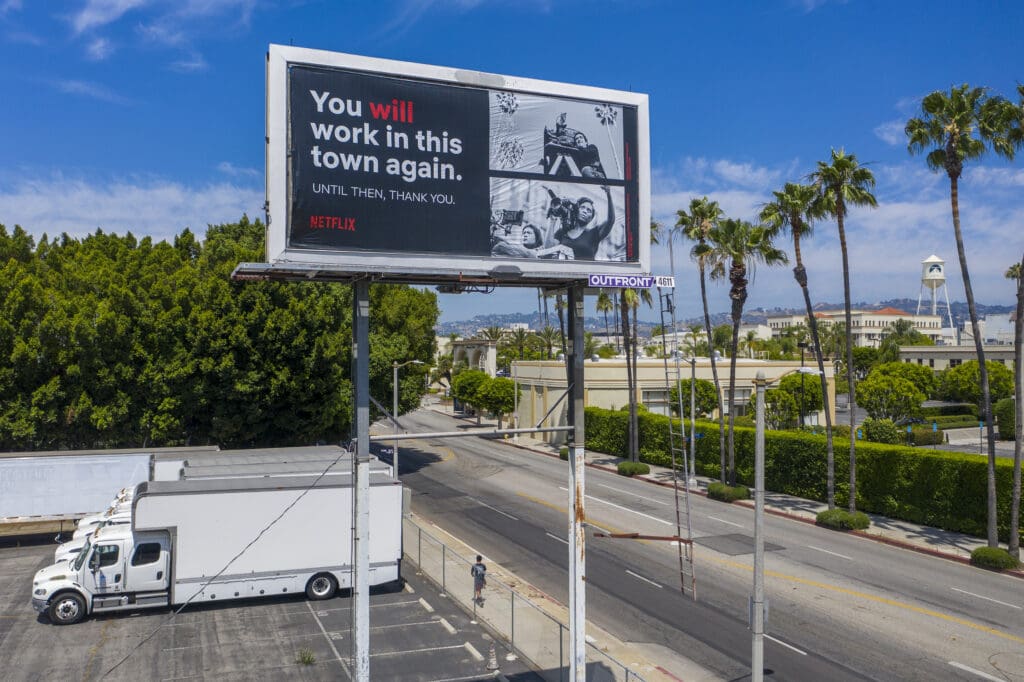
Los Angeles on June 12, 2020, the day of a major reopening of businesses in L.A. County. (Photo by David McNew/Getty Images)
Racial Disparities Amid a Pandemic
Ferrer took the helm of LAC DPH at the start of 2017. Prior to that, she had spent some three decades working in education, public health, research and community advocacy, earning a reputation as a nationally recognized public health leader. A cornerstone of Ferrer’s tenure at L.A. County has been health equity—trying to bridge the enormous disparities that exist in health outcomes between rich and poor, and between white residents and people of color. On Ferrer’s watch the department has launched a multipronged Center for Health Equity initiative—a rarity in public health departments.
Some health care experts say that the public health department’s COVID response in disadvantaged communities should have come much sooner.
When Ferrer came to LAC DPH, she gave it a “new direction,” said Physicians for Social Responsibility executive director Martha Dina Argüello, echoing the view of other social justice advocates. “We were very heartened by what she was saying.”
In late April, a detailed 20-page LAC DPH report showed how COVID-19 cases and deaths were significantly higher among Black and Latino populations compared with white and Asian populations, with poverty another leading factor—findings mirrored in this more recent UCLA analysis. The department promised to improve a suite of measures in vulnerable populations, including better community engagement and improved contact tracing for the hard to reach.
L.A. County is far from alone in witnessing the disproportionate impacts of COVID-19 on disadvantaged communities, and has only recently begun to see reductions in racial disparities. But some experts and advocates say that, given the public health department’s laser focus on health equity under Ferrer’s leadership, coupled with the proposals outlined in its April report, more should have been done much sooner, with glaring holes remaining in LAC DPH’s response.

Los Angeles County Public Health director Barbara Ferrer and Los Angeles Mayor Eric Garcetti. (Photo by Robyn Beck / AFP) (Photo by ROBYN BECK/AFP via Getty Images)
Jill Johnston, an assistant professor of preventive medicine at the University of Southern California’s Keck School of Medicine, argues that not enough is being done by LAC DPH to overcome problems associated with language barriers and deep-seated government mistrust in communities like East L.A., where case and death rates are highest, so that vital information is effectively shared among workers and their families.
Others warn that contact tracing efforts remain limited in poor, nonwhite neighborhoods, even with the increased resources that have recently poured into the program. One former county health official who spoke on condition of anonymity asked: “Why are we not in the communities more, doing the hard work?” The official said that, rather than relying on county and state staff contacting residents by phone, the department should have hired and trained residents to go door to door in the hardest-hit neighborhoods.
“The LAC DPH director has never been held accountable for the failures of LAC DPH.”
–Molly Davies, L.A. County skilled nursing facilities ombudsman
In its April report, LAC DPH stated it would work “closely” with the Department of Health Services, the county’s lead agency on testing, to make it “ubiquitous and more accessible.” But the county was slow to ramp up testing in many underserved areas. And while testing sites have recently increased in vulnerable communities, some health professionals wonder why it took this long. “Why are these testing sites going in so much later?” said Sonali Saluja, clinical fellow at USC’s Schaeffer Center.
Pete White, executive director of the Los Angeles Community Action Network, a Skid Row-based community advocacy organization, also wonders if much of the department’s talk of equity is lip service. Rather than position itself as an ardent advocate of the homeless — a population dominated by people of color — the department has bowed too easily to political pressures, he said, calling the agency’s response in Skid Row during the pandemic a “hot mess.”
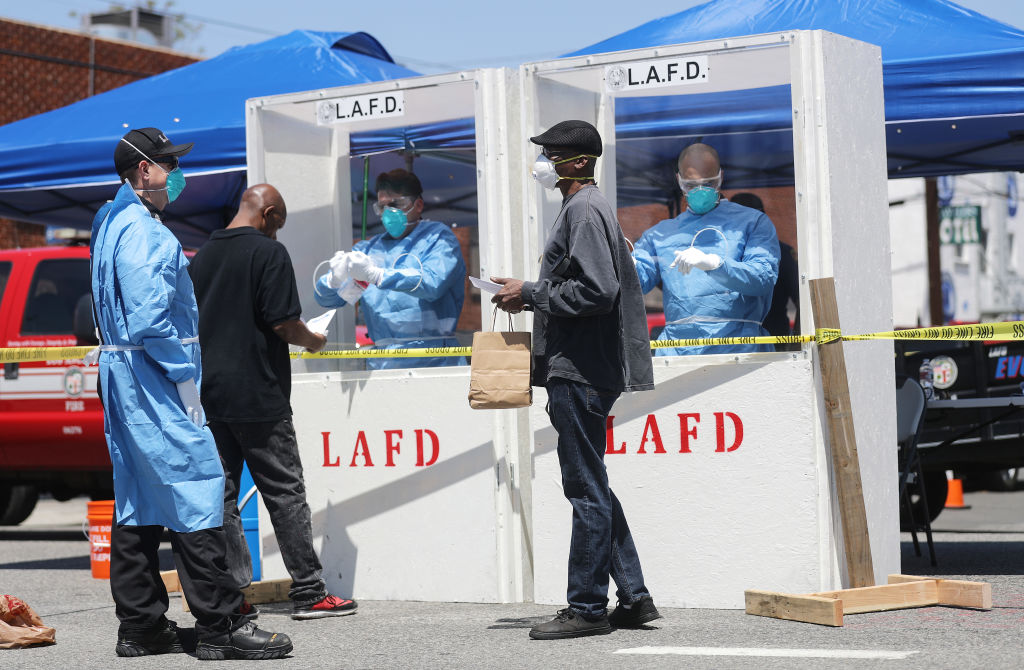
Los Angeles Fire Department members conduct COVID-19 testing in Skid Row. (Photo by Mario Tama/Getty Images)
The department’s defenders point out that L.A. County is a huge, unwieldy boat to steer, and the agency has to battle conflicting local, state and federal political headwinds. “They’re not the only department overseeing this,” said Sonya Vasquez, chief transformation officer at Community Health Councils, a health equity nonprofit. As such, some say that Ferrer can only do so much, especially given existing problems within the department, like outdated health data collection systems.
Earlier, more aggressive testing, contact tracing and infection control enforcement by Ferrer’s department would likely have decreased COVID-19 cases and spared lives among the nursing home workforce.
While the agency’s COVID website dashboard is a good “step forward,” said Argüello, it would need to be integrated into broader health data tracking systems to be truly effective. “But they’re going to need resources for that.”
When asked about some of the concerns raised by community advocates and health professionals, LAC DPH chief deputy director Megan McClaire stressed the pandemic’s historic and unprecedented nature, the evolving nature of the department’s efforts and the collaborative nature of the needed responses.
A department statement claimed that health equity remains a “top priority.” The statement highlighted a series of steps the agency has taken, including a “significant expansion of testing in under-resourced areas,” collaborations with partner community organizations and a 20 percent increase since the beginning of August in completed contact tracing case investigation interviews.
Nursing Home Nightmare
Nursing homes account for approximately one-third of all COVID-19 deaths in L.A. County, with more than 1,800 fatalities. This staggering death toll led the county’s governing body, the Board of Supervisors, to vote unanimously on May 26 to appoint an inspector general to oversee the area’s more than 300 skilled nursing facilities. (See our earlier coverage for details of the nursing home tragedy.)
That decision implicitly rebuked Ferrer and the LAC DPH, which is the only public health agency in California with direct authority over nursing home conditions (skilled nursing facilities in the rest of the state are overseen by the California Department of Public Health). Supervisor Kathryn Barger, who co-authored the inspector general motion, along with Supervisor Mark Ridley-Thomas, expressed little confidence in the LAC DPH and questioned whether the agency was conducting adequate COVID-19 testing in nursing homes. Barger and Ridley-Thomas stipulated that the inspector general report directly to the board rather than to public health authorities.
“The reason she’s failing in that position is that she’s trying to run a health department single-handedly. She doesn’t utilize her health officer. She doesn’t utilize her directors. She should not be in that position.”
— Former senior staff member at LAC DPH
Advocates for nursing home residents have been scathing in their assessment of the department’s response to COVID-19. “They delayed testing that is needed to identify and manage outbreaks. They did not monitor nursing homes with known staffing problems and histories of poor infection control and neglect…. They stopped regular inspections and complaint investigations. They halted all enforcement actions. They’ve done little to contain outbreaks and said less about what they are doing and whether it is working,” wrote Michael Connors of California Advocates for Nursing Home Reform in a statement to Capital & Main in June.
Over the last two months, COVID-19 cases and deaths at nursing homes in L.A. County have slowed. But Dr. Michael Wasserman, president of the California Association for Long-Term Care Medicine, wrote in an email to Capital & Main that “Dr. Ferrer should take responsibility for how her department handled the COVID-19 crisis in Los Angeles County nursing homes. It is clear that they had the necessary information to make the right decisions and didn’t.”
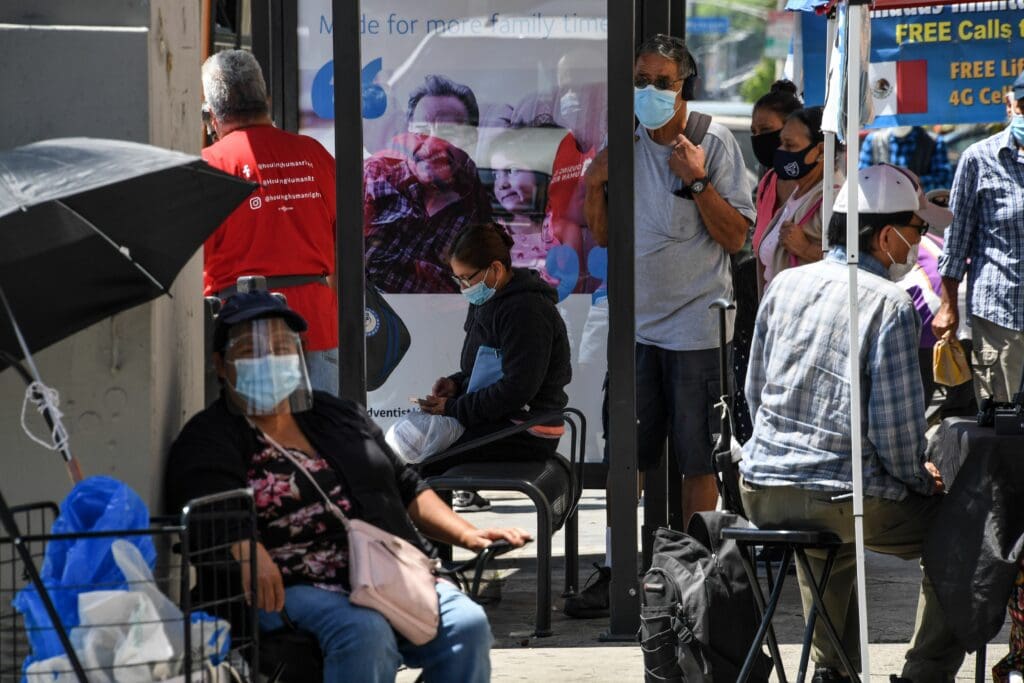
People wait for a bus in the mostly Latino neighborhood of East Los Angeles during the coronavirus pandemic. (Photo by ROBYN BECK/AFP via Getty Images)
In response to questions about how it has handled the COVID-19 nursing home crisis, LAC DPH sent a statement that said, in part, “We’ve instituted stringent requirements in nursing homes and Public Health-approved facilities to prevent the spread of COVID-19. This includes comprehensive testing strategies, appropriate masking, and designated cohort areas and staffing to keep residents who are COVID-19 positive or are suspected to have COVID-19 separate from those who are COVID-19 negative or do not have exposure to COVID-19.”
Molly Davies, L.A. County’s longtime ombudsman for skilled nursing facilities, told Capital & Main that the “LAC DPH director has never been held accountable for the failures of LAC DPH. Lax regulatory oversight has been a persistent and ongoing issue in Los Angeles and California.” Davies added that because LAC DPH has a contract with the state to oversee nursing homes, “The California Department of Public Health and Governor Newsom should be held accountable for continued poor oversight of skilled nursing facilities and the weak COVID response.” Asked if Ferrer should be replaced as head of LAC DPH given the department’s failures to protect nursing home residents, Davies added: “The state should take oversight of L.A. skilled nursing facilities back because L.A. Public Health has continued to fail in their responsibility to hold providers to minimum standards. Removing Ferrer will not fix this problem.”
Lax Workplace Enforcement
Prior to the reopening of many businesses in L.A. County in May and June, people of color were already suffering disproportionate rates of COVID-19 cases and deaths. One reason is the high number of Latinos, African Americans and Asian Americans who serve as essential workers.
“Dr. Ferrer and Mayor Garcetti exhorted us to stay home. Yet at the same time she announced the hotels should reopen to tourists.”
— Kurt Petersen, co-president, UNITE HERE Local 11
When other sectors that depend on people of color got the green light to reopen, the racial dimension of COVID-19’s impact intensified. One example is the hotel industry, which received clearance on June 12 from L.A. County to reopen hotels for tourism and leisure travel, with a set of new safety conditions. While hotels supported this decision, UNITE HERE Local 11, which represents thousands of Los Angeles hotel workers, strongly opposed it. (Disclosure: Local 11 is a financial supporter of this website.)
Reopening hotels to tourism “was reckless and placed hospitality workers, who are mainly immigrants and people of color, in harm’s way,” said Kurt Petersen, co-president of Local 11. “At the time, the pandemic was surging; Dr. Ferrer and Mayor Garcetti exhorted us to stay home. Yet at the same time she announced the hotels should reopen to tourists. Hotels are risky. They are large buildings packed with transient visitors. Mistakes result in outbreaks, and possible deaths.”
Petersen claims that more than 100 hotel workers have tested positive for COVID-19 since the reopening, and that LAC DPH has failed to enforce the conditions under which hotels were allowed to reopen. “We have filed complaints at more than a dozen hotels documenting failure to train workers, failure to enforce mask requirements on guests and failure to adequately track and trace outbreaks. We have pleaded repeatedly with DPH to speak with workers when they inspect workplaces. Yet inspectors only talk to management and not surprisingly they find few problems.”
A statement from LAC DPH said, in part, “Investigations include conversations with the person-in-charge at the time of the inspection, and depending on the complaint, may include conversations with employees.” The statement also said, “DPH and the Los Angeles County Board of Supervisors Offices met with UNITE HERE 11, and Dr. Ferrer has continued to engage with the union.”
Among those hardest hit by COVID-19 in L.A. County have been nursing home workers. LAC DPH reports that nearly 5,900 workers at skilled nursing facilities have been infected and that 52 have died. Nursing home workers are overwhelmingly people of color, with a high percentage of immigrants and women. Earlier, more aggressive testing, contact tracing and infection control enforcement by Ferrer’s department would likely have decreased COVID-19 cases and spared lives among this workforce.
“I pray to God for somebody like a Dr. Ferrer. In a crisis like this, I would rather see a leader bite off more than they can chew because they want to see change.”
— John Kim, executive director, Advancement Project California
The garment industry is another business with a poor record with regard to worker infection rates. According to Marissa Nuncio, director of the Garment Worker Center, a labor advocacy organization, this largely low income workforce is generally unaware of the county health department and its role—a problem exacerbated by a lack of department follow-up with the workers themselves when they report unsafe work practices. “I think that can really dissuade workers from reporting,” Nuncio said. “Really quick and direct response to complainants is very important to encourage workers to keep coming forward.”
In an interview, LAC DPH chief deputy director McClaire said that when it comes to COVID-19 outbreaks in the workplace, businesses bear the brunt of the responsibility. “They’re the ones responsible for creating a healthy working environment.”
Leadership Style
Capital & Main spoke with several former high level LAC DPH officials, all of whom worked directly with Ferrer and who voiced concerns about her leadership style and its impact on the overall effectiveness of the department. All wished to remain anonymous for fear of professional or personal retaliation. One retired LAC DPH senior manager described how Ferrer “pretty much makes everybody funnel everything through her, so that she’s the primary filter for any decision-making.”
Ferrer has also removed important flexibility from the hands of senior management, the former officials say, leading to a department that is less effective because experts in the agency have had their wings clipped. “I think the reason she’s failing in that position is that she’s trying to run a health department single-handedly. She doesn’t utilize her health officer. She doesn’t utilize her directors,” said another former senior staff member at LAC DPH, who added that Ferrer should step down: “She should not be in that position.”
A former senior LAC DPH director contrasted Ferrer with her predecessor, Dr. Jonathan Fielding. “Fielding was deferential to professionals within DPH. He realized that in an agency this big you have to have a management team that is empowered. Barbara doesn’t see the value and is threatened to some extent by the notion that senior staff should have some discretion and be able to take action in the interest of the public.”
Under Ferrer, said the former director, there is “no reform that is allowed to go forward that isn’t coming from Barbara’s head. You can’t as a senior manager move forward as we’ve done before, and in some cases great ideas that would have moved ahead in the past are dead on arrival.”
Others strongly disagree with the critique of Ferrer’s leadership style and throw their weight behind her efforts to tackle the vast health inequalities in the county. John Kim, executive director of the Advancement Project California, a leading nonprofit that works to increase racial equality across the state, describes Ferrer as a dynamic nonbureaucrat. He argues that during her tenure at LAC DPH, she has done the grunt work of laying the foundations for systemic health equity reform, even if it’s too early to see tangible measures of that success.
“I pray to God for somebody like a Dr. Ferrer,” said Kim, whose organization will honor the public health director next month at the Champions for Equity Awards. He added that her “bold” leadership style is right for the occasion. “In a crisis like this, I would rather see a leader bite off more than they can chew because they want to see change.”
Megan McClaire, acting chief deputy director at LAC DPH, vigorously disputes the charges the former high-level officials make with regard to Ferrer’s approach, describing her boss as thoughtful, collaborative and committed in her efforts to address health equity. “She cares about the details,” said McClaire. “I don’t see it in a micromanaging way as much as she tries to understand the details of what transpires.”
To illustrate Ferrer’s collaborative nature, McClaire, whose long working history with the director extends to their time together at the Boston Health Commission, pointed to the expansion of the department’s leadership team under Ferrer’s watch from about six to 18 members. This team, she added, now “more broadly represents the demographics of this county.”
For now, Ferrer appears to have the backing of her bosses, the L.A. County Board of Supervisors. When asked her opinion of the director’s performance, Supervisor Sheila Kuehl said, in part, in an August 20 statement:
“During the pandemic, Dr. Barbara Ferrer has made addressing racial inequity a centerpiece of the department’s strategy. LA County’s Department of Public Health has been waging an uphill battle against a new, unknown virus and its impact on low income people of color. Every major metropolitan area in the country has faced a similar challenge with similar, disheartening outcomes . . . Most of the county’s testing capacity is now concentrated in high poverty areas. As a result of these changes, the County is now beginning to see reductions in the disproportionate impact on low-income communities of color.”
The four other supervisors did not respond to requests for comment.
As a former LAC DPH senior director said of the Board, “They have put their confidence in Barbara.”
Copyright 2020 Capital & Main

-

 Latest NewsDecember 8, 2025
Latest NewsDecember 8, 2025This L.A. Museum Is Standing Up to Trump’s Whitewashing, Vowing to ‘Scrub Nothing’
-

 Striking BackDecember 4, 2025
Striking BackDecember 4, 2025Home Care Workers Are Losing Minimum Wage Protections — and Fighting Back
-

 Dirty MoneyDecember 3, 2025
Dirty MoneyDecember 3, 2025Trump’s Anti-Climate Policies Are Driving Up Insurance Costs for Homeowners, Say Experts
-

 Child FarmworkersDecember 5, 2025
Child FarmworkersDecember 5, 2025To Protect Underage Farmworkers, California Expands Oversight of Field Conditions
-

 Column - State of InequalityDecember 4, 2025
Column - State of InequalityDecember 4, 2025Can California Claw Back Some Medi-Cal Care?
-

 Latest NewsDecember 10, 2025
Latest NewsDecember 10, 2025Capital & Main, L.A. Times Win Sidney Award for Reporting on Child Farmworkers
-

 StrandedDecember 9, 2025
StrandedDecember 9, 2025Giving Up on the Dream: Asylum Seekers Try Other Options in Mexico
-

 Locked OutDecember 16, 2025
Locked OutDecember 16, 2025This Big L.A. Landlord Turned Away People Seeking Section 8 Housing


